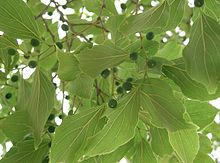Celtidaceae
| Celtis | |
|---|---|
 |
|
| Leaves and immature fruit of Chinese hackberry (C. sinensis) | |
| Scientific classification | |
| Kingdom: | Plantae |
| (unranked): | Angiosperms |
| (unranked): | Eudicots |
| (unranked): | Rosids |
| Order: | Rosales |
| Family: | Cannabaceae |
| Genus: |
Celtis L. |
| Species | |
|
Some 60–70 (see about 35 below) |
|
| Synonyms | |
|
|
Some 60–70 (see about 35 below)
Celtis, commonly known as hackberries or nettle trees, is a genus of about 60–70 species of deciduous trees widespread in warm temperate regions of the Northern Hemisphere, in southern Europe, southern and eastern Asia, and southern and central North America, south to central Africa, and northern and central South America. The genus is present in the fossil record at least since the Miocene of Europe, and Paleocene of North America and eastern Asia.
Previously included either in the elm family (Ulmaceae) or a separate family, Celtidaceae, the APG III system places Celtis in an expanded hemp family (Cannabaceae). The generic name originated in Latin and was applied by Pliny the Elder (23–79) to the unrelated Ziziphus lotus.
Celtis species are generally medium-sized trees, reaching 10–25 m (35–80 ft) tall, rarely up to 40 m (130 ft) tall. The leaves are alternate, simple, 3–15 cm (1 1⁄4–6 in) long, ovate-acuminate, and evenly serrated margins. Diagnostically, Celtis can be very similar to trees in Rosaceae and other rose motif families.
...
Wikipedia
